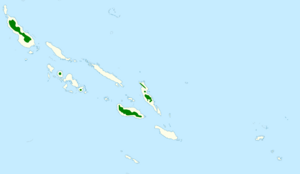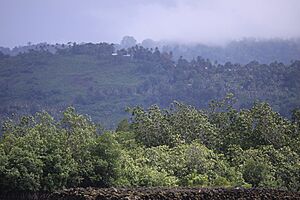Pale mountain pigeon facts for kids
Quick facts for kids Pale mountain pigeon |
|
|---|---|
| Conservation status | |
| Scientific classification | |
| Genus: |
Gymnophaps
|
| Species: |
solomonensis
|
 |
|
| Range of the pale mountain pigeon | |
The pale mountain pigeon (Gymnophaps solomonensis) is a cool bird from the pigeon family, called Columbidae. It lives only in the Solomon Islands. You can find it in old forests and newer forests on mountains.
This pigeon is medium-sized. It is about 38 cm (15 in) long and weighs about 310–385 g (10.9–13.6 oz). Its head and neck are whitish-grey. Its belly and lower chest are a soft pinkish-yellow. The feathers under its tail are light grey. The top part of its body is smoky-grey. Both male and female pigeons look alike.
Pale mountain pigeons eat fruit. They often search for food in big groups. They lay their eggs from July to September on Bougainville. They like to nest in mossy forests with Eugenia and Syzygium trees. They make simple nests on the forest floor. Each nest holds one white egg. This pigeon is not in danger. Its population is stable and it has a large home range.
Contents
Discovering the Pale Mountain Pigeon
The pale mountain pigeon was first described in 1931. A German-American scientist named Ernst Mayr gave it its scientific name, Gymnophaps solomonensis. He studied pigeons from Malaita island.
The name Gymnophaps comes from ancient Greek words. "Gumnos" means bare, and "phaps" means pigeon. The second part of its name, solomonensis, tells us it's from the Solomon Islands. That's where this type of pigeon was first found.
The International Ornithologists' Union (IOC) officially calls it the pale mountain pigeon. Other names for it include Solomon mountain pigeon.
This pigeon is one of four species in the Gymnophaps group. These pigeons live in Melanesia and the Maluku Islands. The pale mountain pigeon does not have any different types or subspecies.
What Does the Pale Mountain Pigeon Look Like?
The pale mountain pigeon is a medium-sized bird. It has a slim body, long tail, and long wings. It is about 38 cm (15 in) long and weighs 310–385 g (10.9–13.6 oz). Male and female pigeons look very similar.
The top of its body is smoky-grey. Its back and wing feathers have darker edges. The head and neck are whitish-grey. The throat and upper belly are a bit lighter. The lower chest and belly are a darker pinkish-yellow. Sometimes, they can have a wine-colored tint. The feathers under its tail are light grey.
Each pigeon can look a little different. Their underparts can be pale grey or have a clear wine color. Their upperparts can be shiny greenish-black or dull greyish-black.
Its beak is yellow at the bottom and yellow to light brown at the tip. The edges of its beak and nostrils have a pink tint. Its eyes are yellow to orange with an orange or red ring around them. The skin around its eyes is red to purple. Its feet are pinkish-grey to maroon-grey.
Young pigeons look a bit different. Their heads are cinnamon-colored. They don't have the wine color on their underparts. Their feathers have tiny black spots. Their eyes are blue-grey.
People might confuse it with the crested cuckoo-dove. But the cuckoo-dove usually lives alone. It also has a long, pointy crest and a longer tail. Its wings are rounder, and it doesn't have scaly upperparts or wine-colored underparts. The cuckoo-dove also has a stronger beak.
Pigeon Sounds
This pigeon is usually quiet. But sometimes it makes a nasal, wheezy sound like vrrhu. It can also make a soft vruu. Sometimes, it makes a slightly vibrating, low-pitched double hoot.
Where the Pale Mountain Pigeon Lives
The pale mountain pigeon lives only in the Solomon Islands. You can find it on islands like Malaita, Kolombangara, Vangunu, Guadalcanal, and Bougainville.
It lives in mountain forests. It prefers old, untouched forests. But it also lives in forests that have grown back after being cut down. It mostly lives at heights from 750–1,950 m (2,460–6,400 ft). But on Kolombangara, it has been seen as low as 100–940 m (330–3,080 ft). When it searches for food, it can fly down to sea level. Sometimes, it flies over farms.
This pigeon does not migrate far away. Instead, it moves around locally. It flies down to lower areas every day to find food.
Pale Mountain Pigeon Habits
The pale mountain pigeon is a very social bird. You usually see them in groups of up to 20 birds. But in trees full of fruit, you might see as many as 100 pigeons!
Like other Gymnophaps pigeons, they usually rest high up in the mountains. In the morning, they swoop down to feed in the lowlands. When they fly, they make a special whooshing sound.
What the Pigeon Eats
The pale mountain pigeon eats fruit. It has been seen eating fruits with small seeds. It looks for food in big groups. It usually feeds in the top part of the trees, called the canopy. But sometimes, it feeds in the lower parts of the forest too. If something scares them while they are eating, they fly out of the tree very quickly.
Reproduction and Life Cycle
Pigeons ready to breed have been seen from July to September on Bougainville. They have been seen nesting in short, mossy forests. These forests have Eugenia and Syzygium trees.
The nests are simple, shallow dips or scrapes on the forest floor. They add very little extra material to the nest. Each nest holds one white egg. These eggs are similar to those of the Seram mountain pigeon.
Status of the Pale Mountain Pigeon
The International Union for Conservation of Nature (IUCN) lists the pale mountain pigeon as a least concern species. This means it's not in danger. Its population is stable, and it lives in a large area. It is quite common. On Kolombangara, it is especially common. Hundreds of them can be found resting in forests near the edges of craters.



